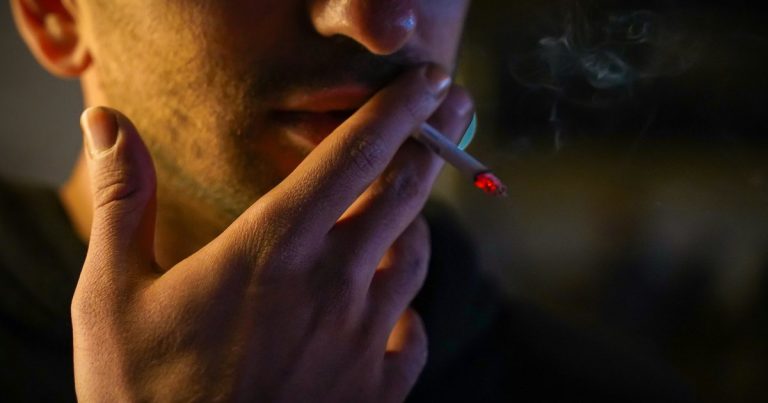According to the Centers for Disease Control and Prevention, tobacco use is more prevalent among LGBTQ+ people than heterosexual and cisgender people.
This disparity could lead to LGBTQ+ people experiencing higher rates of smoking-related diseases, but data is lacking because researchers often don’t ask about sexual orientation or gender identity, said Dr. Jamie Garfield, a pulmonologist at Temple Health.
Garfield leads the UNIQUE (Integrating Interprofessional Learning to Serve Queer Communities Through Education) project, an initiative designed to help Temple University Health internal medicine residents and clinicians improve communication skills, develop empathy and learn about the experiences of transgender and non-binary patients through simulated standardized patient interactions. Garfield also serves as director of LGBTQ curriculum for the Internal Medicine Residency Program at Temple University Lewis Katz School of Medicine.
Garfield and his colleagues identified commercial tobacco as one of the “biggest LGBTQ+ health issues of all time.”
Big Tobacco Companies Target the LGBTQ+ Community
“There is strong evidence that sexual orientation and gender identity minorities report greater exposure to tobacco advertising,” Garfield said. “These communities are more exposed to tobacco advertising than cisgender and heterosexual people, and there is data that greater exposure to tobacco advertising is associated with higher rates of tobacco use.”
When tobacco companies began featuring gay and lesbian people in their ads in the 1990s, “it was exciting for LGBTQ people because for the first time they were seeing themselves represented as a kind of community that you share everyday things with your partners and loved ones,” Garfield said. “But of course it was very intentional to create a market.”
Philip Morris donated large amounts of money to AIDS causes in 1991 after gay men boycotted Marlboro cigarettes because of the company’s support for Senator Jesse Helms, an opponent of gay rights.
In 1995, R.J. Reynolds Tobacco Company launched a cigarette marketing campaign called “Project SCUM,” an acronym for “Subculture Urban Marketing,” targeted gay men and homeless people in San Francisco.
Tobacco companies continue to market directly to the LGBTQ+ demographic through targeted advertising in LGBTQ media, nightlife marketing, donations, sponsorships, and other tactics.
High rates of smoking in the LGBTQ+ community
About 1 in 6 gay, lesbian, and bisexual adults smoke, compared with about 1 in 9 heterosexual adults, according to CDC statistics.
According to a 2022 survey, lesbian, gay, and bisexual high school students use tobacco products at approximately 1.5 times the rate of their heterosexual peers. Similarly, 20.5% of transgender high school students use tobacco products, compared to 14.8% of cisgender high school students.
A 2021 study found that transgender and gender-expansive adults are twice as likely to smoke cigarettes as their cisgender counterparts, and a 2019 study found that transgender youth are four times more likely to use tobacco than cisgender youth and three times more likely to use e-cigarettes than cisgender youth.
According to a 2023 Federal Trade Commission report, 36% of LGBT smokers use menthol cigarettes, compared with 29% of straight smokers. Studies have shown that menthol cigarettes are more addictive and harder to quit than unflavored cigarettes, but efforts by the Food and Drug Administration, health advocacy groups and lawmakers to ban menthol cigarettes have stalled.
Barriers to quitting smoking
Proven treatments to help people quit smoking include counseling and FDA-approved medications, but Garfield said people in the LGBTQ+ community are less likely to seek or receive smoking cessation help than their heterosexual and cisgender counterparts.
“They have a harder time quitting because they are less likely to have access to counseling services, quit lines or pharmacotherapy, and this has to do with quit lines and counseling services being less targeted to their communities,” Garfield said. “They feel they are not understood or supported.”
A 2018 report by Public Health Solutions, a New York organization that works to reduce health disparities, concluded that lesbian, gay, and bisexual people are five times less likely to call a quitline due to discrimination, poverty, rejection from family and friends, and other factors. The report also found that gay, bisexual, and transgender men are 20% less likely than straight men to be aware of quitlines, and only 28% of LGBT people use nicotine replacement therapy, even when covered by insurance.
In a survey of Colorado adults who smoke, lesbian, gay, and bisexual adults who were aware of the state’s quit line were less likely than heterosexual adults to report intending to call the line.
According to the 2022 U.S. Transgender Survey, one in four transgender people report not seeking medical attention when they needed it in the past 12 months due to fear of mistreatment.
“People in the queer community, particularly the transgender and gender diverse community, are afraid to access healthcare in many ways because of discrimination, so it’s imperative that healthcare providers who are knowledgeable and understand these disparities make themselves known,” Garfield said. “It’s clear that unless we raise more awareness and help more people in our community get support and quit, we’re going to see an increase in the incidence of all kinds of tobacco-related diseases.”
The Need for Change
To reduce barriers to smoking cessation and prevent tobacco-related diseases in the LGBTQ+ community, Garfield said the following actions are needed:
• More clinicians will be gender-affirming by wearing pronoun pins, using inclusive, patient-centered language, and understanding the disparities and unique needs of this population.
• Including LGBTQ people in leadership positions within healthcare organizations
• Provide culturally appropriate education and training for health care workers and engage members of the LGBTQ+ community.
• Include gender and sexual minorities in local, state, and national surveys of smoking behavior.
• Include demographic data from the LGBTQ+ community in data collection and research on topics related to smoking.
• Include specific messages directed at gender and sexual minorities in all media campaigns aimed at strengthening tobacco education and awareness-raising efforts.
gd2md-html: xyzzy Thursday, July 18, 202


